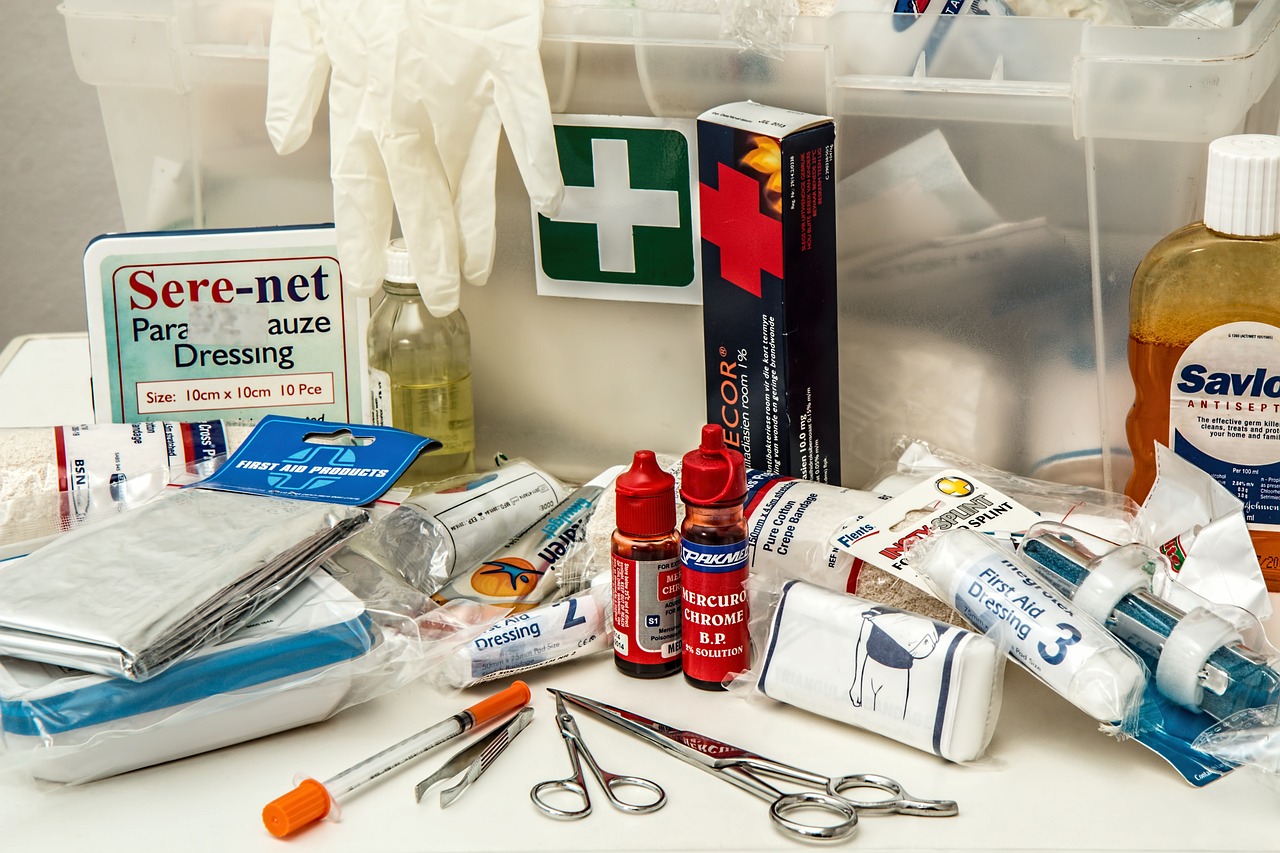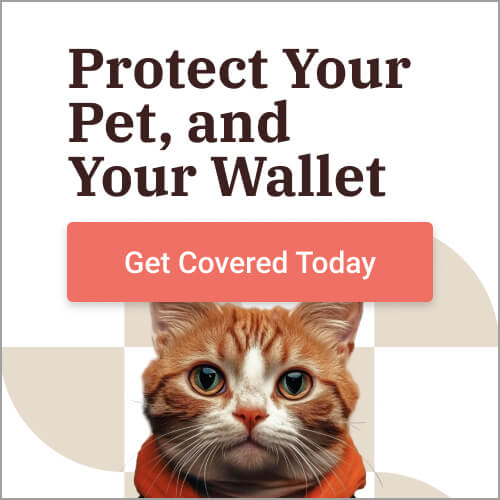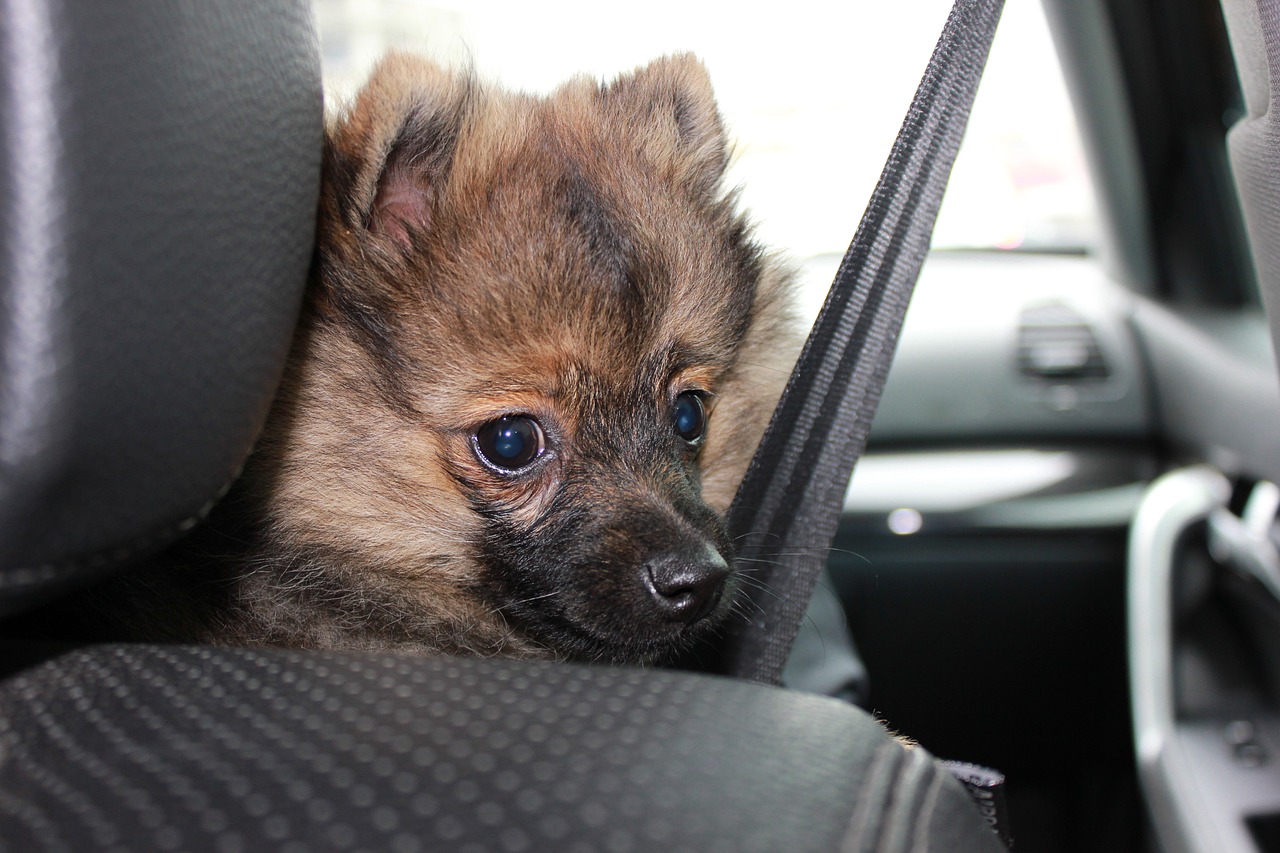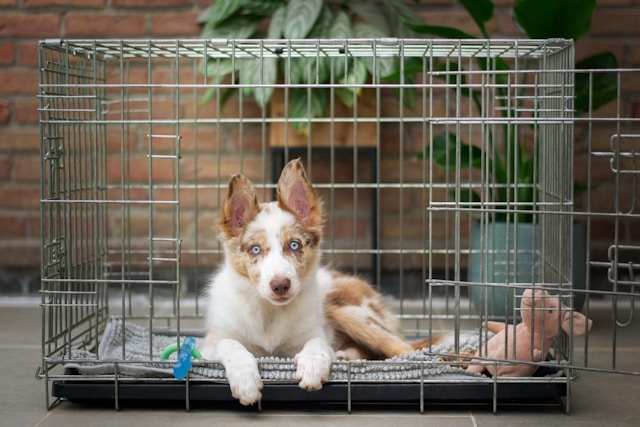First Aid Checklist For Your Pet

Keep this checklist handy:
-
Veterinarian's contact information: Include numbers for your family veterinarian and an after-hours emergency veterinarian for quick access.
-
Scissors: Useful for cutting hair and bandages as needed.
-
Tweezers: Essential for safely removing objects from your pet's skin or paws.
-
Eyedropper: To dispense liquid medication or clean superficial wounds.
-
Gloves: Protect yourself and keep wounds sanitary with disposable gloves.
-
Gauze pads: Use these to clean injuries and wounds.
-
Gauze rolls: Ideal for wrapping around wounds or creating a safety muzzle.
-
Soft muzzle: Prevent your pet from biting or chewing on an injury while in pain. Various sizes are available, and you can find them at veterinary clinics and pet stores.
-
E-collar: An opaque or transparent plastic, cone-shaped protector that attaches to your pet's collar. It helps prevent your pet from accessing a wound or injury.
-
Alcohol prep pads: Sterilize items such as scissors or tweezers.
-
Cold pack: Great for reducing swelling or providing pain relief.
-
Digital thermometer: Determine if your pet has a fever without the risk of a mercury thermometer shattering.
-
Hydrogen peroxide: Keep it on hand for cleaning wounds.
-
Rags or rubber tubing: Useful as a tourniquet in emergencies.
-
Blanket or towel: Wrap your injured pet, carry them, and provide warmth and comfort.
Rabies Precautions To Consider:
Animals in pain may resort to biting. It's crucial always to have proof of your pet's rabies vaccination. Depending on state regulations, a pet without current rabies vaccination documentation may face quarantine.
Disaster Preparedness:
Natural disasters can strike anywhere and anytime. Whether it's an earthquake, storm, or wildfire threatening your home, ensure your pet's well-being by storing a few weeks' worth of food in an easily accessible container and having ample water. This preparation alleviates one less worry as you work to keep your family safe.
Additional First Aid Tips For Pet Owners
Are you prepared for potential pet emergencies? What if your dog ingested chocolate, your cat experienced a seizure, or your pet faced overheating on a scorching summer day? Equipping yourself with basic first aid knowledge can help you stay calm and take immediate action when needed. While it doesn't replace professional veterinary care, it can be a lifesaver until you can reach a vet. In case of an emergency, contact your veterinarian or a local veterinary emergency hospital to inform them of your situation. When traveling with your pet, consider a compact travel-sized pet first aid kit and have essential contact numbers on hand, including your vet, the national animal poison control hotline (888-426-4235), and a nearby 24-hour emergency veterinary facility. When leaving your pet behind while traveling, ensure that those caring for them have the information to keep your furry companion safe and healthy.
Consider Your Safety:
An injury can inflict pain on your pet and lead to fear and confusion. These emotions might cause even the most gentle pets to become unpredictable or potentially dangerous. To safeguard both you and your furry companion:
-
Refrain from attempting to hug an injured pet.
-
Maintain a safe distance from your pet's mouth.
-
Utilize a muzzle if your pet exhibits signs of aggression.
-
When feasible, enlist assistance from others when handling your injured pet.
What To Do If Your Pet Ingests Poison Or Toxins:
Poisoning is a critical issue for pet owners and can often lead to confusion. Generally, substances harmful to humans are equally hazardous to pets. This includes cleaning agents, rodent poisons, and antifreeze. Additionally, it's crucial to be aware of common household items, plants, and other substances that may threaten your pet. Take note of common domestic hazards that could endanger your pet's well-being.
Check the Label:
If your pet comes into contact with a toxic product like many cleaning agents, refer to the product label for instructions for human exposure. If the label advises washing hands with soap and water following exposure, similarly cleanse your pet's skin with soap and water, avoiding contact with their eyes, mouth, or nose. If the label recommends flushing the skin or eyes with water, undertake this for your pet promptly (if safely possible) and promptly contact a veterinarian.
Seek Assistance:
If you suspect that your pet has ingested or been exposed to a potentially harmful substance, or if your pet is experiencing seizures, loss of consciousness, unconsciousness, or breathing difficulties, urgently reach out to your veterinarian, an emergency veterinary facility, the Animal Poison Control Center hotline (888-426-4435), or Pet Poison Helpline (855-764-7661). Please be aware that hotline or helpline calls may entail consultation fees. When making contact, try to provide the following details:
- Species, breed, age, sex, weight, and the number of animals involved
- Present symptoms
- Name or description of the substance in question; quantity ingested by the animal; and the time elapsed since the pet's exposure or consumption
- Product container or packaging
- If your pet has vomited or chewed on any material, gather it and place it in a sealable plastic bag to bring along when seeking veterinary care for your pet.
What To Do If Your Pet Is Injured, Bleeding, Or Bitten
Fractures:
- Gently place your pet on a flat surface for proper support.
- If feasible and safe, attempt to stabilize the injury through bandaging or splinting before relocating your pet. If unsure, it's best to leave this to the veterinarian since an improperly applied bandage or splint can cause more harm.
- While transporting your injured pet to a veterinary facility, confine them in a small area to minimize the risk of further injury. Pet carriers are suitable, or you can utilize a box or another container, ensuring ample ventilation. For larger dogs, utilize a board, sled, blanket, or similar item as a makeshift stretcher.
Internal Bleeding:
- Keep your pet warm and maintain a quiet environment.
- Immediately transport your pet to the nearest veterinary hospital.
- Signs of internal bleeding encompass bleeding from the nose, mouth, or rectum; coughing up blood; bloody urine; pale gums; collapsing; and a weak, rapid pulse.
External Wounds:
- Employ a clean cloth or towel to apply steady pressure directly over the bleeding area.
- Refrain from verifying if the bleeding has ceased until at least three minutes of pressure application.
- If bleeding is severe, promptly transport your pet to the closest veterinary hospital. If you notice blood seeping through the applied cloth or towel, refrain from removing it; instead, add more towels to safeguard any potential blood clots that may have formed.
Burns:
- Flush the burn with water at room temperature, taking precautions to avoid injury, such as using a muzzle to prevent scratching, biting, or harm.
- Cover the burned area with damp towels at room temperature.
- Seek immediate veterinary attention.
Eye Injuries:
- Eye injuries can be painful and rapidly deteriorate, threatening your pet's vision.
- If you can discern something in your pet's eye, such as dirt or grass, try gently flushing it out with a saline solution.
- Avoid attempting to remove the object with tools or your fingers.
- Prevent your pet from rubbing their eye against objects or using their paws.
- Promptly seek veterinary care.
Snake Bites:
- Assume the snake is venomous and seek immediate veterinary care.
- If possible, attempt to identify or photograph the snake while maintaining a safe distance. Refrain from attempting to capture or kill the snake.
- Do not bring the snake to the veterinarian's office; a photograph will suffice.
What To Do If Your Pet Experiences Heatstoke Or Goes Into Shock
Heatstroke:
- Heatstroke signs encompass rapid breathing or heavy panting, excessive drooling, weakness or drowsiness, confusion, vomiting or diarrhea, and abnormally colored, dry, or sticky gums.
- Rapidly transport your pet to the nearest veterinary hospital while initiating cooling measures.
- If your pet is in direct sunlight, relocate them to a shaded area or a comfortably cool indoor space.
- Gently place towels dampened with room-temperature water around your pet's neck, armpits, and groin region. Regularly rehydrate and replace these towels every few minutes.
- Avoid immersing your pet in a cool or cold water tub, as it can exacerbate their condition.
- If a fan is accessible, employ it to direct cool air towards your pet.
Shock:
- Shock is indicated by a weak pulse, shallow breathing, nervousness, and dazed eyes, often occurring following severe injury or extreme fright.
- Ensure your pet remains restrained, warm, and in a quiet environment.
- If your pet is unconscious, maintain their head level with the rest of their body.
- Immediately transport your pet to the nearest veterinary hospital.
What To Do If Your Pet Experiences A Seizure
- Ensure your pet is kept away from any objects, including furniture, that might pose a risk of injury. Do not attempt to restrain the pet or startle them out of the seizure.
- Refrain from placing your hands in or near your pet's mouth.
- Use a watch to time the duration of the seizure.
- After the seizure concludes, maintain a warm and quiet environment for your pet and promptly contact your veterinarian or the nearest emergency hospital.
Immediately seek veterinary attention if your pet has encountered any of the following:
- Two or more seizures within a 24-hour timeframe.
- A seizure lasting longer than 5 minutes.
- Seizure activity that does not cease.
What To Do If Your Pet Is Choking
If your pet is choking, watch out for signs such as difficulty breathing, excessive pawing at the mouth, choking sounds during breathing or coughing, and possible bluish discoloration of the lips or tongue.
- If your pet can still breathe, maintain a calm environment and seek immediate veterinary assistance.
- If feasible and without risking harm, carefully open your pet's mouth to inspect for foreign objects.
- If you identify an object, gently attempt to remove it by using both hands to open the mouth, then employing your fingers to grasp and extract the object. If necessary, you can use the flat side of a spoon to help dislodge it but do not push it further down the throat.
- For small dogs and cats, if you cannot remove the object with your fingers, lift your pet by their thighs and gently swing them from side to side. If this doesn't dislodge the object, apply gentle pressure to the abdomen behind the ribcage.
- For larger dogs, consider using the Heimlich maneuver if the object remains lodged and can't be removed manually. If your large dog is standing, encircle their belly with your arms, similar to how you would assist a person, and create a fist with your hands. Position your fist on the soft area beneath their ribcage, then push upward and forward. If your dog is lying down, place one hand on their back and use the other hand to apply upward pressure to the abdomen.
What To Do If Your Pet Stops Breathing
In case your pet is not breathing, follow these steps:
- Remain composed and stay calm.
- Gently open your pet's mouth and pull its tongue forward, ensuring the tip extends outside the mouth.
- Swiftly examine the mouth and throat for any foreign objects obstructing the airway.
- Administer rescue breaths by closing your pet's mouth with your hand and delivering breaths directly into their nose until you observe their chest expanding. After the chest expands, continue to provide 10 rescue breaths per minute until your pet begins breathing independently or until you reach the nearest veterinary hospital.
What To Do If Your Pet Has No Heartbeat
If your pet has no heartbeat, follow these steps:
- Begin rescue breathing as explained for non-breathing pets.
- Initiate chest compressions:
- For cats and most dogs, gently place the pet on one side. For barrel-chested dogs (such as English Bulldogs), lay them on their back and position your hands on their breastbone.
- In the case of small dogs and cats, use one hand to encircle the base of the chest between your thumb and other fingers. Compress the chest by squeezing it between your thumb and fingers at a rate of 100-120 times per minute (to the rhythm of "Stayin' Alive").
- For larger dogs, position your hands over the widest part of the chest or, for keel-chested dogs (like Greyhounds or Doberman Pinschers), just behind the armpit. Apply downward pressure at a rate of 100-120 times per minute while keeping your elbows straight.
- Aim to compress the chest cavity by about one-third of its total width.
- If you are alone, alternate between chest compressions and rescue breaths. Perform 30 chest compressions and then pause briefly to provide two rescue breaths, then repeat. If you have assistance, one person can perform chest compressions while the other delivers 10 rescue breaths per minute.
- Continue these efforts until you can detect a heartbeat and observe regular breathing in your pet or until you reach the nearest veterinary hospital, where they can take over. Remember that the chances of successful resuscitation for your pet are generally very low, but it may offer the only opportunity for survival in emergencies.
Get insurance plans with wide-ranging coverage options













